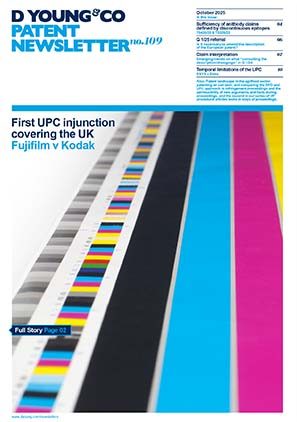EPO description amendments: the saga continues
There was a collective sigh of relief from many European Patent Office (EPO) users when, towards the end of 2021, an EPO Board of Appeal set aside a decision of the Examining Division to refuse a patent application on the basis of the description not having been adapted to bring it into conformity with an allowable set of claims.
T 1989/18: adaptation of the description of a European patent application
The EPO Board of Appeal considered whether there was legal basis for refusing an application if the description was not adapted to the subject matter of the claims.
Read moreThe issue is far from settled, however, with conflicting Board of Appeal decisions since being issued and the March 2022 edition of the EPO’s Guidelines for Examination maintaining the requirements to amend the description.
Why is this an issue?
Under European patent law the scope of protection sought via a European patent application is defined by the claims. Example ways of working the invention (so-called “embodiments”) are described in the description. During the prosecution of a patent application, the scope of the claims may be changed. For example, to render the claims novel and inventive over cited prior art, the scope of the claims may be narrowed. This may cause some of the original embodiments in the description to no longer fall within the scope of the claims.
The position of the EPO (at least according to the latest Guidelines for Examination) is therefore that corresponding amendments should be made to the description. For example, embodiments no longer falling within the scope of the claims should either be deleted or marked as “not according to the claimed invention”. Applicants, however, often have good reason for not wanting to make such amendments to the description.
First, there may be diverging views between the examiner and the applicant as to whether or not a particular embodiment falls within the scope of the amended claims.
Second, there are often corresponding patent applications in other jurisdictions which, due to the differences in patent law between jurisdictions, may provide a different sought scope of protection to the European patent application. Stating in the text of the European patent application that a particular embodiment is “not according to the claimed invention” may therefore cause problems down the line in these other jurisdictions (for example, in post-grant infringement or validity proceedings).
Third, reviewing and amending the description in its entirety is often a non-trivial task which can take significant amounts of time. This results in cost being incurred by the applicant in addition to the costs already incurred in obtaining an allowable set of claims.
On the other hand, it is important for any granted patent to be an internally consistent legal document and for the scope of protection conferred by that patent to be completely clear.
What does the law say?
The European Patent Convention (EPC) does not directly address the need to amend the description to bring it into conformity with an amended set of claims. It does, however, contain a number of provisions which are commonly cited in the case law.
Perhaps the most important is Article 84 EPC: “The claims shall define the matter for which protection is sought. They shall be clear and concise and be supported by the description.”
There is also Rule 42(1)(c) EPC: “[The description shall:] disclose the invention, as claimed, in such terms that the technical problem, even if not expressly stated as such, and its solution can be understood, and state any advantageous effects of the invention with reference to the background art.”
Furthermore, Rule 48(1)(c) EPC states: “[The European patent application shall not contain:] any statement or other matter obviously irrelevant or unnecessary under the circumstances.”
There is also Article 69(1) EPC, relating to the extent of protection conferred by a European patent or patent application. However, given that it is national courts (and, soon, the Unified Patent Court (UPC)) rather than the EPO which have jurisdiction to decide on the extent of protection conferred by a patent, it seems that the Boards of Appeal (with the exception, perhaps, of T 1024/18) are reluctant to give too much weight to this provision.
The case law
The current requirements for amending the description according to the Guidelines for Examination (in particular, Part F-IV 4.3) seem to be based primarily on T 1808/06. Here, the Board of Appeal concluded that: “In order to meet the requirement of Article 84 EPC that the claims have to be supported by the description, the adaptation of the description to amended claims must be performed carefully in order to avoid inconsistencies between the claims and the description/drawings which could render the scope of the claims unclear.”
T 1808/06 of 14 February 2008
Read the full decisionT 1808/06 is well-established. It was the March 2021 version of the Guidelines for Examination, however, which explicitly introduced and elaborated on the specific requirements for amending the description. Many EPO users found the requirements particularly onerous and it was the most commonly-raised issue during the EPO’s subsequent Guidelines for Examination consultation.
Consultation on EPC and PCT-EPO Guidelines – Spring 2021
View the consultation (pdf)T 1989/18 was published in December 2021. This decision diverged from T 1808/06, stating: “Article 84 EPC only mentions the description in the context of the additional requirement that it must support the claims. … [I]f the claims are clear in themselves and supported by the description, their clarity is not affected if the description contains subject-matter which is not claimed.”
Accordingly, Article 84 EPC could not serve as legal basis for refusing a patent application simply because the description had not been adapted.
It was also concluded that the relevant passages of the description did not impair the “understanding of the technical problem and its solution” required under Rule 42(1)(c) EPC and that there were no legal consequences in the EPC for having “obviously irrelevant or unnecessary” matter in the patent application according to Rule 48(1)(c) EPC.
T 1024/18 was published in March 2022. It explicitly diverged from T 1989/18 by interpreting the need in Article 84 EPC for the claims to be “supported by the description” as the description being consistent with the claims “not only in some part but throughout”. Any inconsistency between the description and the claims therefore meant the claims were not supported by the description as required by Article 84 EPC.
T 1989/18 (Adaptation of the description/HOFFMANN-LA ROCHE) of 16 December 2021
Read the full decisionRecently, T 1444/20 (published in April 2022) took a similar interpretation to T 1989/18. It concluded there was nothing to suggest that “the current claims are not clear in themselves to a person skilled in the art”. It was also found that the “Specific embodiments of the invention” mentioned in the description (which appeared to be considered as “claim-like clauses”) could not be mistaken for claims. Article 84 EPC therefore could not be used as a justification for objecting to the claims.
T 1444/20 also concluded that, in the absence of an objection under Article 82 EPC (that is, a lack of unity of invention), Rule 42(1)(c) EPC did not “translate into a requirement to bring the description in line with claims intended for grant, and to remove passages of the description that disclose embodiments which are not claimed” and that the description did not “impair the understanding of the technical problem and its solution”. T 1444/20 also explicitly agreed with much of the analysis of T 1989/18 regarding Rule 48(1)(c) EPC. It was thus concluded that neither Rule 42(1)(c) EPC nor Rule 48(1)(c) could be used as justification for refusing the application.
T 1444/20 of 28 April 2022
What next?
These cases do seem to relate to slightly different scenarios. For example, T 1444/20 is focused on the deletion of “claim-like clauses”. T 1024/18 relates primarily to a specific embodiment in the description being inconsistent with the claims. T 1989/18 considers the specific case of an embodiment in the description with a broader scope than the claims. However, they all relate to the issue of whether or not a patent application can be refused for not complying with the EPC because of apparent discrepancies between the claims and the description. There does not appear to be a consistent answer to this.
The EPC does, of course, anticipate such scenarios. To ensure uniform application of the law, Article 112 EPC provides for questions of law to be referred to EPO’s Enlarged Board of Appeal by either the Board of Appeal or the President of the EPO. So, it might not be surprising if we see the question of description amendments being referred to the Enlarged Board of Appeal before too long.
In the meantime, in these uncertain times, we can expect EPO users to continue to try their luck arguing for whichever interpretation of the law best helps their case.


